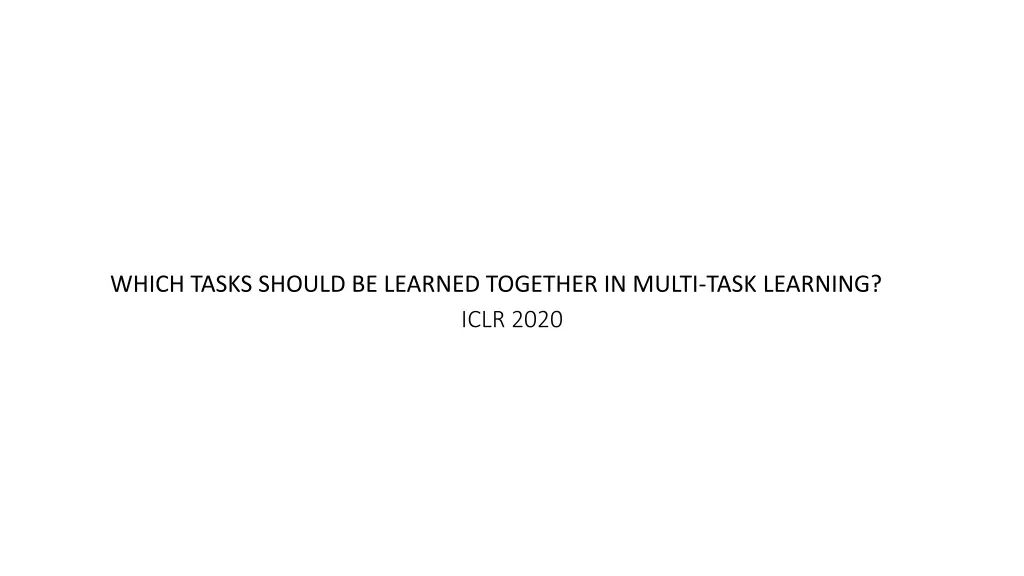
Learning Together: Multi-Task Learning in ICLR 2020
Explore the concept of multi-task learning, where multiple related tasks are solved with a single model, leading to reduced training and inference time. Discover the benefits of hard and soft parameter sharing, objectives in task sets, candidate networks evaluation, early stopping approximation, higher-order approximation, and insights from the Taskonomy dataset. Uncover the results and key findings from this innovative approach presented at ICLR 2020.
Download Presentation

Please find below an Image/Link to download the presentation.
The content on the website is provided AS IS for your information and personal use only. It may not be sold, licensed, or shared on other websites without obtaining consent from the author. If you encounter any issues during the download, it is possible that the publisher has removed the file from their server.
You are allowed to download the files provided on this website for personal or commercial use, subject to the condition that they are used lawfully. All files are the property of their respective owners.
The content on the website is provided AS IS for your information and personal use only. It may not be sold, licensed, or shared on other websites without obtaining consent from the author.
E N D
Presentation Transcript
WHICH TASKS SHOULD BE LEARNED TOGETHER IN MULTI-TASK LEARNING? ICLR 2020
Multi-task Learning Solve multiple related tasks with one single model (less training time/less inference time) Model focuses on all tasks Knowledge of one task can be inductively shared to perform other tasks Probability of overfitting is very low Hard Parameter Sharing Soft Parameter Sharing
Objectives Set of tasks = (t1,t2, ..,tk) Maximum allowable inference time b The overall performance for a solution S is We want to find the solution with the lowest overall loss and a cost that is under our budget
Candidate Networks Set of tasks = (t1,t2, ..,tk) Number of tasks = | | Evaluate the performance of tasks, where- | |C1 refers to number of single task models | |C2 refers to number of models that solve task pairs | |C3 refers to number of models that solve any 3 tasks And so on.. To evaluate the size of the networks, additional | | networks with half computational cost were also trained So, a total of networks were evaluated If there are 5 tasks, 36 number of networks were evaluated
Early Stopping Approximation (ESA) Stop training after utilizing 20% of the training data Pearson-Correlation between ESA-validation-loss and Complete-validation-loss is 0.49 So, the task relationship trends stabilize early Reduces the time burden 20x Takes fewer than 150 GPU hours [1 GPU hr. = 1 GPU * 1 Day] Has some prediction accuracy penalty Higher Order Approximation (HOA) Predicts higher orders from lower ordered network Performance of A-B, B-C and C-A networks tell us about the performance of A-B-C network Saves 50% training time Also comes with prediction quality penalty For example, if you have networks, a&b with losses 0.1&0.2, b&c with 0.3&0.4, and a&c with 0.5&0.6, the per-task loss estimate for a network with a&b&c would be a = (0.1 + 0.6)/2 = 0.35, b = (0.2 + 0.3)/2 = 0.25 and c = (0.4 + 0.6)/2 = 0.5.
Taskonomy dataset 5 tasks: Semantic Segmentation, Depth Estimation, Surface Normal Prediction, Keypoint Detection, and Edge Detection 1 semantic task, 2 3D tasks and 2 2D tasks The data was obtained from 3D scans of about 600 buildings 4M examples- 3.9M training, 0.05M validation, 0.05M test Model selection Modified Xception Network Encoder Decoder Inference time unit = 1 SNT (Standard Network Time)






















